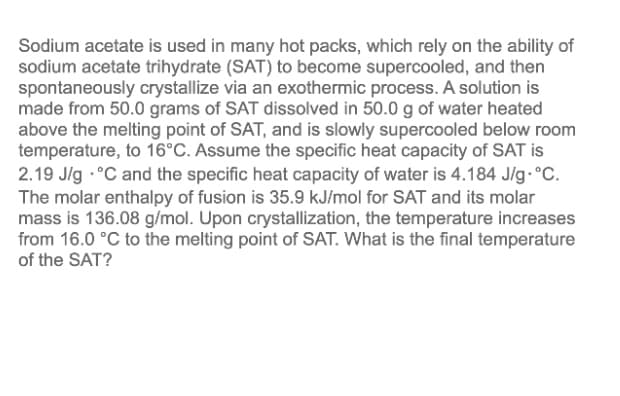Sodium acetate is used in many hot packs, which rely on the ability of sodium acetate trihydrate (SAT) to become supercooled, and then spontaneously crystallize via an exothermic process. A solution is made from 50.0 grams of SAT dissolved in 50.0 g of water heated above the melting point of SAT, and is slowly supercooled below room temperature, to 16°C. Assume the specific heat capacity of SAT is 2.19 Jig °C and the specific heat capacity of water is 4.184 Jig °C. The molar enthalpy of fusion is 35.9 kJ/mol for SAT and its molar mass is 136.08 g/mol. Upon crystallization, the temperature increases from 16.0 °C to the melting point of SAT. What is the final temperature of the SAT?
Carbohydrates
Carbohydrates are the organic compounds that are obtained in foods and living matters in the shape of sugars, cellulose, and starch. The general formula of carbohydrates is Cn(H2O)2. The ratio of H and O present in carbohydrates is identical to water.
Starch
Starch is a polysaccharide carbohydrate that belongs to the category of polysaccharide carbohydrates.
Mutarotation
The rotation of a particular structure of the chiral compound because of the epimerization is called mutarotation. It is the repercussion of the ring chain tautomerism. In terms of glucose, this can be defined as the modification in the equilibrium of the α- and β- glucose anomers upon its dissolution in the solvent water. This process is usually seen in the chemistry of carbohydrates.
L Sugar
A chemical compound that is represented with a molecular formula C6H12O6 is called L-(-) sugar. At the carbon’s 5th position, the hydroxyl group is placed to the compound’s left and therefore the sugar is represented as L(-)-sugar. It is capable of rotating the polarized light’s plane in the direction anticlockwise. L isomers are one of the 2 isomers formed by the configurational stereochemistry of the carbohydrates.

Trending now
This is a popular solution!
Step by step
Solved in 4 steps









